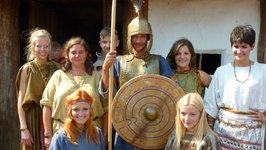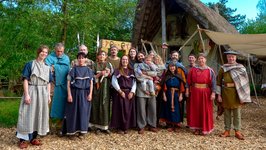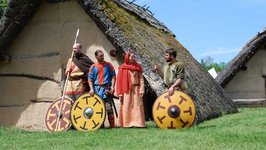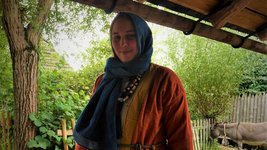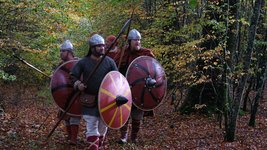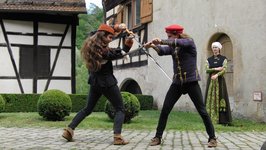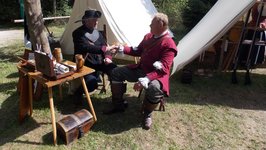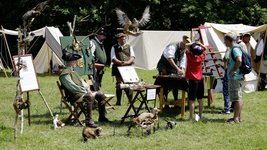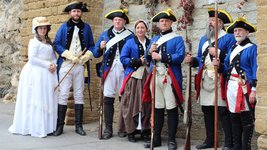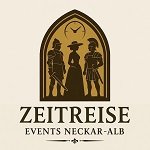Living History Day 2025
On September 6th from 10am to 6pm and September 7th from 10am to 5pm, the Museum of the University of Tübingen MUT, together with the Institute for Prehistory, Early History and Medieval Archaeology, invites you to take part in an archaeological journey through the centuries for the second time – in the historic setting of Hohentübingen Castle.
From the Stone Age to the Celts and Romans to the Middle Ages and early modern times, selected groups will vividly present everyday life in past eras. With faithful reconstructions, authentic clothing and a wealth of expertise, they will bring ancient worlds back to life.
Visitors can expect a varied and interactive programme for the whole family: whether it's flint working, Roman legionaries, Celtic craft techniques or medieval everyday life – everywhere you can ask questions, marvel and join in. This makes history tangible, understandable and exciting for young and old alike.
Refreshments are also provided: in the castle courtyard, orchard farmer Christian Schmid, the Hills Burger Club team and the MUT team will treat guests to cool drinks, red sausages, crispy fried potatoes, tarte flambée, vegan tarte flambée and homemade waffles.
Get a preview with our trailer!
Palaeotechnics
Palaeotechnics offers a scientifically well-founded and practical examination of Europe's Stone Age cultural heritage – from the Upper Palaeolithic to the Neolithic. The work focuses on the reconstruction and practical implementation of prehistoric craft techniques, with a particular emphasis on flint working and leather and fur processing using traditional tanning methods. Based on archaeological finds and incorporating ethnological analogies, a vivid, fact-based picture of Stone Age material culture is conveyed, bringing humanity's oldest crafts to life.
aurea-aetas – Golden Age
Since around 2008, we have been working on the representation of material culture, weaponry, and traditional clothing from the Bronze Age in Germany, with a focus on southern Germany. Our work is based on extensive research in excavation reports and specialist papers in the field. One focus is on the reconstruction of the clothing worn by the various groups of the Tumulus Culture, which we present in our models. On our display table, we show different reconstructions from the various cultural groups.
CARNYX
The CARNYX group, named after the ancient Celtic war trumpet, was founded in 1999 by archaeologists and history enthusiasts from Tübingen. Together with the TEUTA OPIE group, it offers hands-on Celtic history and provides insights into numerous facets of Celtic life between the 6th and 1st centuries BC. These include traditional costumes, jewellery and clothing, as well as the equipment and armament of Celtic warriors. Artistic and innovative craft techniques are demonstrated and exhibited, such as the production of jewellery, textiles and chain mail, coin minting, grain milling with various mills and cooking in large cauldrons. There is also much more to learn about the Celts and their world.
VEX LEG VIII AVG
The 'VEX LEG VIII AVG – Interest Group for Experimental Archaeology and History Education' was founded in 1991. Since 1984, replicas of weapons and equipment have been created – from research and material procurement to replication, experimentation and didactic preparation. Numerous civil and military topics have been covered since then. The group is not concerned with re-enacting Roman life. Rather, the replicas are presented in their functional context in order to stimulate interest in and understanding of the original exhibits.
Bodanohuntari
The members of Bodanohuntari have set themselves the task of recreating everyday life and material culture in Alamannia. They base their work primarily on regional grave finds from the northern Lake Constance area, the Upper Rhine and up to Baar. The spectrum of exhibits ranges from the manufacture of clothing and leatherwork to the production of lighting, as well as the presentation of weapons and tools.
Austrasigenae
The Austrasigenae project – literally ‘those originating from East Franconia’ – was founded in 2016 by Johannes and Isabell Guilleaume to specialise in museum and media appearances with high historical standards alongside the main group of the early medieval association ‘Der Frankenklan’. The main focus is on the life and everyday culture of the East Frankish rural population of the Merovingian period around 600 CE in what is now Mainfranken. In addition to civilian (craftsman) representations with trades such as tablet weaving, coin minting and woodworking, the equipment also includes military and clerical representations and an early medieval writing workshop.
HIWISCA
HIWISCA is a familia from the Carolingian period around 800 CE. A group of nobles, armoured horsemen, merchants, pilgrims, landowners, craftsmen and many others have joined forces to brave the dangers of their perilous journey together. The route takes us from the northern Lake Constance region to the Wendland on the eastern border of the Frankish Empire.
HIWISCA provides a broad insight into the social structure, military affairs and trade of the time.
Grifenstain 1270
The project ‘Grifenstain 1270’ is named after the Middle High German name for the castle and noble estate of Greifenstein on the northern edge of the Swabian Alb, not far from the town of Reutlingen. The members of the group provide insights into the everyday life and material culture of a typical castle garrison at the turn of the High to Late Middle Ages in the late 13th century. The entourage of the Lord of Greifenstein includes noble knights and ladies as well as servants, maids, attendants and ordinary soldiers. Craftsmen also lived and worked at the castle or in the nearby town. The group demonstrates the craftsmanship of a shoemaker, a chain mail maker, textile craftsmen, tailors and dyers.
With its ‘living history’ presentations, the group supports the educational work of a research project at the University of Tübingen on medieval rule in Greifenstein.
Watch the Greifenstein project trailer!
Lebendige Schwertkunst
Lebendige Schwertkunst (Living Sword Art) has set itself the goal of reconstructing historical martial arts from Europe, particularly southern Germany. Our late medieval group focuses on the period around 1470, which produced the books that interest us most: beautifully illustrated fencing manuscripts that enable us to revive martial arts that had almost been lost. We portray citizens of this historical period who learn fencing for fun (ze schimpf) and for self-assertion (ze ernste).
Historical Field Chancellery
The ‘Verbund Historische Feldkanzlei und Feldwache Tilly’ (Historical Field Chancellery and Field Guard Tilly association) offers an insight into the period from 1618 to 1648. As part of the field camp, including the field chancellery, we show visitors reprints of historical writings, reports, maps and coins from the 17th century.
In addition, we present everyday objects and equipment as well as a selection of historical weapons from that period. Our aim is to provide a broad overview of this era.
Herzoglich Wirtembergische Wildjaegers
The Herzoglich Wirtembergische Wildjaegers (Ducal Wurttembergian hunters) are happy to take you back to the 18th century and give you an insight into the training, equipment and respective functions, professional world and clothing of the simple civilian hunters in the ducal forests at that time. These hunters were responsible for hunting and game management, preventing/prosecuting poaching in the ducal forests, and organising and hosting feudal hunts for the amusement of the nobility. The hunters were therefore highly regarded and well liked by the nobility, as they provided highly entertaining pastimes for the upper classes.
However, these hunters were not military personnel, i.e. they were not military field hunters!
Herzoglich Wirtembergisches Füsilierregiment v. Truchsess
The ‘IG Füsilierregiment v. Truchsess’ (Fusilier Regiment von Truchsess) was one of the regiments that Duke Carl Eugen von Württemberg established as a so-called subsidy regiment for France. These hastily recruited and poorly equipped troops were then drawn into the turmoil and battles of the Seven Years' War in 1757.
The group shows not only the everyday life of soldiers, such as drills, guard duty and combat duty, but also the quieter side of military life, including pay, the office, camp followers, catering, recruitment and the more refined world of the officers



![[Translate to Englisch:] Mann in Leder- und Fellkleidung mit Speer](/fileadmin/_processed_/d/b/csm_pal%C3%A4otechnik_8989669b16.jpg)
